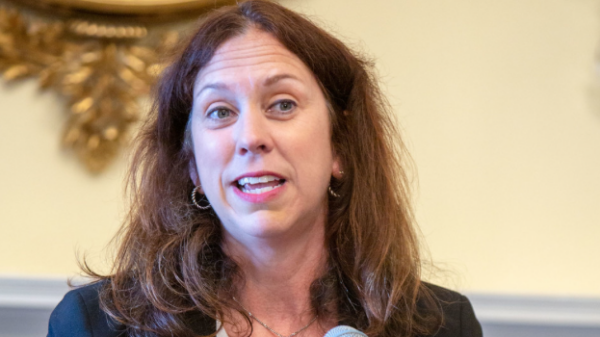By Dr. Greg Carr, Special To The Hilltop
Posted 11:05 AM EST, Thurs., Sept. 15, 2016
Editor’s Note: Dr. Greg Carr is an Associate Professor of Africana Studies and Chair of the Department of Afro-American Studies at Howard University and Adjunct Faculty at the Howard School of Law. He holds a Ph.D. in African American Studies from Temple University and a JD from the Ohio State University College of Law. Below, Carr describes his encounter with Shakur in 1993, as well as his reflection of Shakur’s impact to the world. 2016 marks 20 years since Shakur’s murder. You can follow Carr on Twitter at @AfricanaCarr.
An old photo circulating on social media has prompted my students to ask about the time, in the summer of 1993, that I spent a few hours with Tupac Shakur. We spoke as part of a panel conversation with Black teenagers at a session on education at the 23rd annual Indiana Black Expo. My dear friend (now Howard faculty colleague) Valethia Watkins, Brian Muata Harris, Dr. Khalid Abdul Muhammad, Tupac and I talked with them about self-knowledge and our collective responsibility to use it for community empowerment and transformation.
Tupac channeled the content and energy in the room to connect that young audience to strategies for overcoming the often-harsh realities of Black life in America. He was growing before our eyes, surrounded in part by an entourage of elders from his mother Afeni’s generation who were clearly trying to partially shield him from the worst effects of popular culture forces that he fought to both appropriate and repurpose until the end of his life, 38 short months later.
Tupac’s role the previous year as “Bishop” in “Juice,” the major motion picture and directorial debut by Spike Lee’s long-time collaborator and Howard alum Ernest Dickerson, had turbo-charged his rapid shift from rapper/celebrity to pop culture icon. I am still of the belief that the film played a major and unintended part in crafting America’s image of Tupac, fundamentally altering and in some ways narrowing the way he was engaged by individuals and institutions for the rest of his life.
Only four months before “Juice’s” release in January 1992, Tupac’s debut solo album, “2Pacalypse Now,” a mix of social critique and sensationalistic riffs in the vein of Hip Hop’s newly-ascendant “gangsta pose,” had produced two signature tracks, “Trapped,” and a song that will echo in the oriki of African America for many generations, the haunting “Brenda Got a Baby.” The latter song had endeared him to a nation of young Africans, as would later anthems like “Keep Your Head Up,” “Dear Mama” and “Changes.”
We had planned to sit with Tupac a day earlier at the request of Marshariki Jwanzaa, who organized the panel for IBE on behalf of the Indianapolis Public Schools. Marshariki and her husband Kamau, long-time cultural workers and founding leaders of the National Coalition of Blacks for Reparations in America (N’COBRA), had mastered using IBE as a place where annual intergenerational meetings of African community workers took place. They hosted a screening earlier in the week of the remarkable and newly-released film “Sankofa,” followed by a talk and dinner with its director, the legendary filmmaker and Howard University professor Haile Gerima. It was my first time meeting Gerima, now my long-time brother and colleague. A master teacher, he had trained Dickerson, Bradford Young and many other Black filmmakers at Howard.
Tupac had a last-minute change of plans: He was taken that day to visit his friend Mike Tyson, who was serving a prison term in Indiana after a rape conviction for an incident that happened, ironically, at the Indiana Black Expo two years earlier. In his absence, we discussed how to integrate Tupac into our plans.
The next day, as we arrived at the Indianapolis Convention Center for our panel, hundreds in the young audience were already in place, crackling with anticipatory electricity. We had barely arrived when Tupac entered the room from a side entrance near the stage, a smallish figure, dwarfed and surrounded by a small group of elders. The audience exploded with cheers, shrieks and flashes from disposable cameras. He grinned his trademark mega-watt smile, mounted the stage and embraced each of us warmly. We retreated to a space behind the stage curtain where we reviewed what each of us would discuss and how it would fit together. Tupac’s smile was gone, replaced with a deeply engaged demeanor. As we talked, I remember thinking how comfortably he fell into the conversation. He was remarkably focused and engaged as we began to chart our collective trajectory. As we all talked and decided the order of presentation, a conspiratorial enthusiasm in our small circle took off: We made a pact to spit fire. We agreed that Tupac should go last, and that he should “take the crowd home” with a powerful summary.
There is a full video recording of that day, although a snippet of only Tupac’s remarks have made it to social media and to the documentary “Tupac: Resurrection.” We laughed afterwards that each of us had upped the energy ante and set him up to have to top our intensity. He agreed, laughingly, and we talked with him and his elders about all the connections we shared in common. In that small group were members of most of the major Black Nationalist formations of the previous thirty years. I have often remarked since that Tupac had some of the best women and men of the Black Power era as his advisors, but America refused to stop until they had robbed him of his time and place to grow into his birthright.
Twenty-three years later, so many of the points Tupac raised echo in today’s young movement leaders and artists. A new generation calls out. And I remember previous moments of self-awareness, proto-revolutionary desire, and a man with a boyish enthusiasm and the heart of a warrior, only a few years younger than I was at the time, whose body is gone but whose spirit, like that of all his and all of our ancestors, endures.































